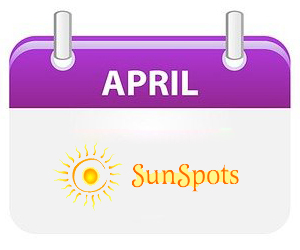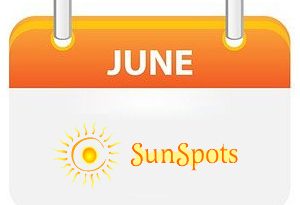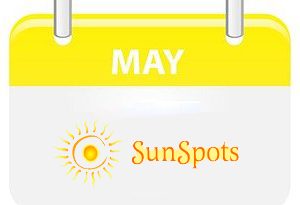Sunspots – April
April 3, 1956
On April 3, 1956 there was an attempted bank holdup on North Road in which the bad guys used a machine gun for the first time in Greater Vancouver crime history. Just after 10:00 a.m. at the Royal Bank at 403 North Road three masked guys burst into the bank—one of them armed with a Thompson submachine gun—threatened the tellers, stuffed $10,000 into a paper bag and turned to leave.
They didn’t make it.
The bank manager had tripped the alarm and three RCMP officers responded to the call. One of them was Constable Bud Johnstone who got into a gunfight with the felons. Johnstone was shot eight times—eight times—but managed to kill one of the men and wound another. The surviving two bandits and their driver were all captured and Johnstone was rushed to Royal Columbian Hospital. Two bullets were taken from his chest and one from his hip. Five other bullets had passed completely through his arms, hand and shoulder.
The next day in the hospital Const. Johnstone, with his wife Edith by his side, was chatting with a Vancouver Sun reporter (unnamed.) Johnstone was promoted to Corporal while still in his hospital bed. We’re not surprised.
April 4, 1930
In 1930 Paul Whiteman’s band was a very big deal. A Vancouver Sun story April 2 on his impending arrival from the States to play in the Vancouver Theatre referred to the April 4 visit as an “epoch . . . one of the outstanding events of Vancouver’s musical history.” The visit “is being looked forward to by thousands of lovers of music. Booking is going ahead merrily at the box office . . .” Whiteman’s big orchestra had featured players like Tommy Dorsey, Joe Venuti, Bix Beiderbecke and a singer named Bing Crosby. Whiteman had commissioned and first played George Gershwin’s Rhapsody in Blue. Even better, the orchestra was also going to play for dancers at the Hotel Vancouver. His music, said the Sun, is “far superior to the regular run of dance music, which was then mostly wild as to wailing clarinets and crazy rhythms.”
Alas, it was not to be. On April 4, Mr. A.E. Skinner, immigration commissioner, forbade the dance concert. “Musicians,” he said, “are debarred from entering Canada except as ‘entertainers.’” In playing for dances, Skinner continued, they are not “entertainers.”
Whiteman responded that if his orchestra couldn’t play for the dancers it wouldn’t perform in the theatre either. And he and his band packed up their epoch and left for Seattle.
April 9, 1927
It must be fun to be a Governor General. Lord Willingdon of Ratton, our 13th, and Lady Willingdon packed a lot of activity into a three-day visit here, arriving April 9, 1927. They went immediately to Stanley Park, with a small mob of dignitaries, to meet a larger mob. “Hundreds of Boy Scouts, Wolf Cubs, Girl Guides and Sea Cadets,” reported The Vancouver Sun, “were in waiting for Lord Willingdon, chief scout of Canada. Lady Willingdon was president of the Girl Guides of Canada.”
They went up Grouse Mountain to watch some fancy skiing, and enjoyed it so much they stayed much longer than scheduled. Lord W played 18 holes of golf at Jericho, while Lady W spoke to the Women’s Canadian Club. Then they boarded the Norsal for a trip up to the Britannia Mine, “the greatest copper mine in the British Empire.”
Next they turned the first sod for what would become the Anglican Theological College on the UBC campus, then popped over to “inspect logging operations at Port Haney.”
Finally, they were guests at a fancy dinner at the Hotel Vancouver, where Lord Willingdon spoke. And, to top it all off, they named a street for him.
April 10, 1985
On April 10, 1985, Vancouver boxer Michael “The Silk” Olajide, Jr. won the Canadian middleweight title at the Agrodome with a ninth-round TKO over Winnipeg’s Wayne Caplette.
Sounds straightforward, but it was anything but. Olajide, born December 8, 1963 in Liverpool, had come with his family to Vancouver in 1970, had been a local favorite since he started boxing in 1981. He won his first 23 fights. The fight with Caplette was his 12th. By the ninth round Caplette had had it. “His trainer,” the Vancouver Sun’s Pete McMartin wrote, “tried to stop the fight by throwing in the towel.”
The referee told the trainer to get back in his corner. Caplette, who had seen the towel thrown in, dropped his gloves. “Olajide,” McMartin continued, “then hit the unguarded Caplette with a crushing left-right combination . . . Caplette crashed to the floor.”
Olajide won, but the crowd booed him. He went on to take part in 20 more fights, losing the last three, and that and eye injuries prompted him to get out of boxing in 1991. He wears an eye patch today.
And makes a good living with athletic fitness programs and working as a fight technician on boxing movies.
April 11, 1911
Did the stage performer Mandrake the Magician inspire the famous comic strip of the same name, or was it the other way around?
Leon Mandrake, who became famous in the 1940s as Mandrake the Magician, was born April 11, 1911 in New Westminster. At age 11 he was on the stage of the Edison Theatre there, and at 16 started touring North America. He was billed then as “Leon,” and later as “Leon the Ventriloquist.” By the mid-1940s he was billed as “Mandrake the Magician.”
The title character in the comic strip Mandrake the Magician—it debuted June 11, 1934—was said to be drawn to resemble him. But Mandrake’s son, Lon, also a magician, says that who inspired what or whom has become too tangled to sort out.
Here’s what James Randi says in his book, Conjuring: “It appears that cartoonist Lee Falk had come up with the name Mandrake independently, basing it upon the claimed miraculous powers of the poisonous plant of the same name. Phil Davis, the eventual artist of the cartoon strip, even changed the look of his character somewhat to match Leon [Mandrake, whose real name is not known]’s appearance after the two met. It was an excellent symbiosis, each entity enhancing the other.”
April 17, 1913
Batter up! On April 17, 1913 Vancouver had a new place to watch professional baseball. It was called Athletic Park and it opened at the southeast corner of Fifth and Hemlock. The park was built by Bob Brown, who would come to be known as Mr. Baseball here. Brown had purchased the Vancouver Beavers club of the Northwestern League for $500 in 1910. He was the club’s owner, president, manager and shortstop.
The Beavers would play the Tacoma Tigers, and it was reported that Brown was “feeling quite chesty” about his team’s chances. He had good reason to be: star pitcher Bob Ingersoll would be on the mound, “given the honor of twirling the first league game at Athletic Park.” Butch Belford, a former Vancouver player, would “do the heaving for Iron Man Joe McGinnity’s Tigers.”
Ingersoll’s twirling beat Belford’s heaving: our guys won 8-4 before 4,000 appreciative supporters, “the largest crowd of fans that ever turned out to witness a ball game in the Terminal City.”
The Beavers went on to win the league pennant. Alas, the club disbanded at the end of the 1922 season, and the city went without pro ball for 15 years.
April 18, 1913
When the Canadian Pacific Railway decided Coal Harbour would be the western terminus of their trans-continental line, they set in motion events that led directly to the birth of Port Coquitlam. The CPR extended its line from Port Moody to Coal Harbour, and that made New Westminster unhappy. New West was the biggest city on the mainland, with a population of 4,000, and they wouldn’t be ignored. So the railway—motivated by a cash subsidy of $75,000 and other goodies—built a spur line down to the Royal City.
The point where the spur line left the main line, 27 kilometres east of Vancouver, was dubbed “Westminster Junction.” Locals just called it the Junction. It was part of Coquitlam. Then agitation began to break away from Coquitlam and make the Junction its own little town.
On Port Coquitlam’s Inauguration Day April 18, 1913, a little over a month after incorporation, and today, there was a parade (delayed by a passing train!), the city band played and the children took part in races. To mark the event Mayor James Mars presented each child with a small silver medallion, a replica of the city’s emblem with its motto: By Commerce and Industry We Prosper.
Port Coquitlam was off and running.
April 24, 1955
Vancouver had 65 years of electric streetcar service. The city’s first streetcars rattled into service June 27, 1890 following a rectangular route along Main, Cordova, Granville and Pender streets. As the system expanded, many of our neighborhoods — Fairview, Kitsilano, Mt. Pleasant, Cedar Cottage, Kerrisdale, Grandview — would be created by the arrival of new lines.
Vancouver was quick off the mark in using electric cars. (We beat Toronto and Montreal by two years.) In fact, the company had already started to plan for horse-drawn transit, even built a big stable. But then, at the cost of a delay of months in beginning, the decision was made to go electric — though some potential passengers had to be assured by local newspapers of their safety from electric shock. (A 2003 book, Vancouver’s Glory Years: Public Transit 1890-1915, by Heather Conn and Henry Ewert, is a wonderful and profusely illustrated record of that era.)
Finally, inevitably, Vancouver’s electric streetcar service came to an end. Cars and trolley buses had made them obsolete. “Amidst flashbulbs and the tears of fans,” the last car (which included Henry Ewert among its passengers) clanked into retirement on April 24, 1955. That Buzzer (from the collection of transit buff Jim McGraw) tells the story.
April 25, 1955
A new era in rail travel made it into the papers April 25, 1955. The Canadian Pacific Railway had introduced, the night before, The Canadian, an “Ultramodern, lightweight, highly attractive stainless-steel streamlined train.” The train offered the world’s longest dome ride: 2,881.2 miles.
Postwar Canada believed train travel had a healthy future. Canadian Pacific met the demand by introducing this fancy new service. (The last car of each train featured original murals by painters of the Group of Seven.)
The Canadian was faster than the existing Dominion service: Running time from Vancouver to Montreal was just over 71 hours. The Dominion, which made many more stops, took about 108.
Engineer R.J. McQuarrie pulled his 14-car train out of the CPR’s Cordova Street station at 8:00 p.m. April 24. There were just over 300 passengers aboard, and a crew of 22.
At 1:00 p.m. Montreal time on the same day the westbound Canadian left for Vancouver.
The Canadian was responsible for a spike in the number of train travellers, but, sadly, it was short-lived. Today, VIA Rail runs the Canadian just three times a week (and on CN rails). And a trip that cost $77.85 in April of 1955 (one-way coach Vancouver to Montreal) will set you back about $730 today.




